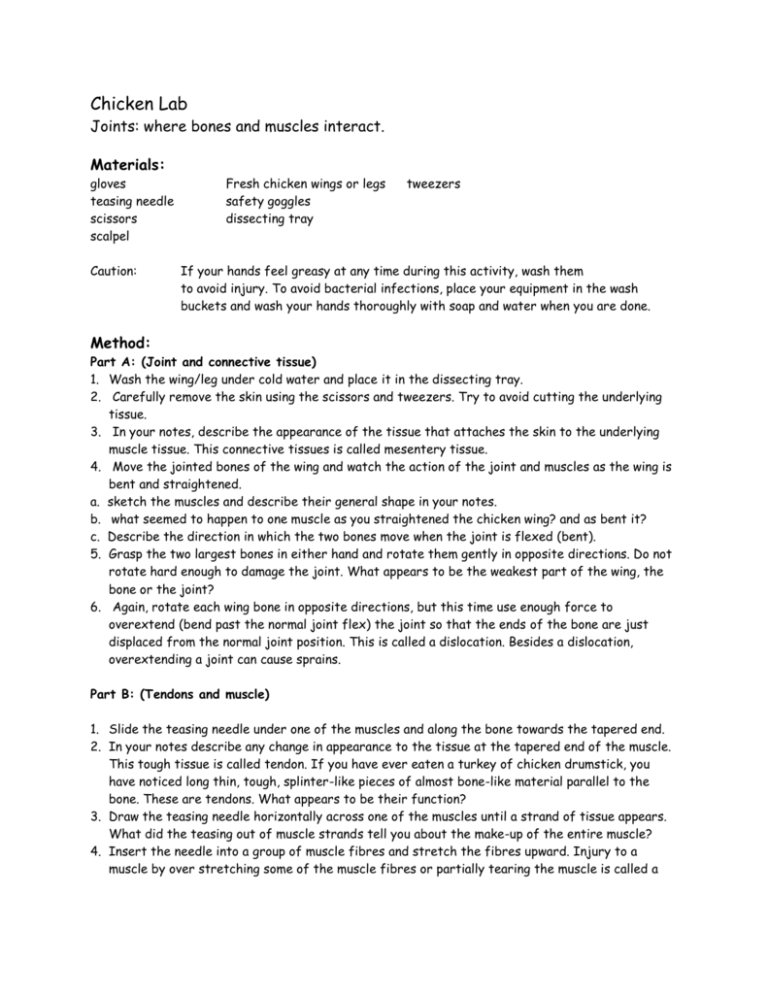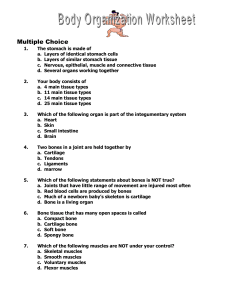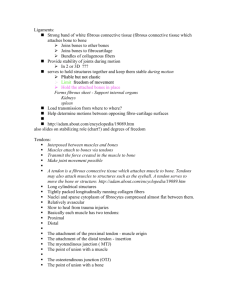chicken lab
advertisement

Chicken Lab Joints: where bones and muscles interact. Materials: gloves teasing needle scissors scalpel Caution: Fresh chicken wings or legs safety goggles dissecting tray tweezers If your hands feel greasy at any time during this activity, wash them to avoid injury. To avoid bacterial infections, place your equipment in the wash buckets and wash your hands thoroughly with soap and water when you are done. Method: Part A: (Joint and connective tissue) 1. Wash the wing/leg under cold water and place it in the dissecting tray. 2. Carefully remove the skin using the scissors and tweezers. Try to avoid cutting the underlying tissue. 3. In your notes, describe the appearance of the tissue that attaches the skin to the underlying muscle tissue. This connective tissues is called mesentery tissue. 4. Move the jointed bones of the wing and watch the action of the joint and muscles as the wing is bent and straightened. a. sketch the muscles and describe their general shape in your notes. b. what seemed to happen to one muscle as you straightened the chicken wing? and as bent it? c. Describe the direction in which the two bones move when the joint is flexed (bent). 5. Grasp the two largest bones in either hand and rotate them gently in opposite directions. Do not rotate hard enough to damage the joint. What appears to be the weakest part of the wing, the bone or the joint? 6. Again, rotate each wing bone in opposite directions, but this time use enough force to overextend (bend past the normal joint flex) the joint so that the ends of the bone are just displaced from the normal joint position. This is called a dislocation. Besides a dislocation, overextending a joint can cause sprains. Part B: (Tendons and muscle) 1. Slide the teasing needle under one of the muscles and along the bone towards the tapered end. 2. In your notes describe any change in appearance to the tissue at the tapered end of the muscle. This tough tissue is called tendon. If you have ever eaten a turkey of chicken drumstick, you have noticed long thin, tough, splinter-like pieces of almost bone-like material parallel to the bone. These are tendons. What appears to be their function? 3. Draw the teasing needle horizontally across one of the muscles until a strand of tissue appears. What did the teasing out of muscle strands tell you about the make-up of the entire muscle? 4. Insert the needle into a group of muscle fibres and stretch the fibres upward. Injury to a muscle by over stretching some of the muscle fibres or partially tearing the muscle is called a strain. A common strain occurs in the lower back when heavy objects are lifted using the back muscles instead of the legs. Part C: (Ligaments) 1. Use the scalpel to remove the muscles from the bone but leave the tissues holding the joint intact. The tough, fibrous tissue that holds bones together at a joint is called a ligament. 2. Move the bones by bending and straightening the joint several times. What happens to the ligament as the joint is bent and straightened? 3. In your notes, describe the elasticity of the ligament compared to the tendon. Ligaments control the direction in which bones can move at a joint. When you stretch elastic or a metal spring, less energy is required to start the stretch than at the stretching limit. If it is overstretched past this limit, the elastic or spring may break or be unable to return to its original shape. If pressure is placed on a joint between tow bones in a manner that caused the ligament to stretch in the wrong direction or past its stretching limit, as with the spring or elastic, a painful sprain or a strained ligament results. Ligaments have no ability to contract. They simply have some degree of elasticity in the direction that the tow bones at the joint are supposed to move. The elasticity stiffens and resists further movement when the joint reaches its maximum flexibility. Ligaments are formed from a tissue called cartilage. There are three types of cartilage in the human body, each having a different structure and function. All cartilage is alike, however, in that it contains no blood vessels. When we find cartilage in the cooked version of the chicken we eat, we call it ‘gristle’. Part D: (Bone and cartilage) 1. Cut the ligament that holds the two bones together, and examine the ends of the bones forming the joint. How do they differ in appearance from the central shaft of the bone? 2. Use the scalpel to cut into the smooth which covering at the joint ends of the bone. This tissue covering the ends of the bone is also called cartilage. Is this cartilage protecting the ends of the bone hard or soft? How do you know? Caution Be careful while using the scalpel. Bone is made of a combination of minerals of calcium carbonate and calcium phosphate woven into a matrix with fibres of the protein collagen. Early in life, our skeletal bones are mainly solid cartilage. As we develop, the bones harden and begin to develop hollow centres. This process of becoming hollow changes the strength only slightly but greatly lowers the mass of the bones. Because strength and low mass are combined, you need less energy to move the bone.








